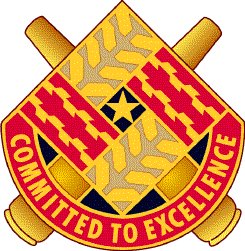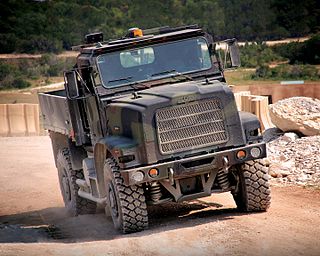
A self-driving car, also known as an autonomous vehicle (AV), driverless car, or robotic car (robo-car), is a car incorporating vehicular automation, that is, a ground vehicle that is capable of sensing its environment and moving safely with little or no human input. The future of this technology may have an impact on multiple industries and other circumstances.
The Combat Capabilities Development Command (CCDC) Soldier Center, now CCDC SC was formerly the United States Army Natick Soldier Research, Development and Engineering Center, and is a tenant unit of the United States Army Natick Soldier Systems Center (SSC), or Soldier Systems Center Natick. CCDC SC is a military research complex and installation in Natick, Massachusetts charged by the U.S. Department of Defense with the research and development of food, clothing, shelters, airdrop systems, and other servicemember support items for the U.S. military. The installation includes facilities from all the military services, not just the Army, and is so configured to allow cross-service cooperation and collaboration both within the facility and with the many academic, industrial and governmental institutions in the Greater Boston Area.

The Combat Capabilities Development Command (CCDC) C5ISR Center, formerly the Communications-Electronics RD&E Center (CERDEC), is the United States Army information technologies and integrated systems center. CCDC C5ISR Center is headquartered at Aberdeen Proving Ground in Maryland, with activities at Fort Belvoir in Virginia and Joint Base McGuire-Dix-Lakehurst in New Jersey.

An unmanned ground vehicle (UGV) is a vehicle that operates while in contact with the ground and without an onboard human presence. UGVs can be used for many applications where it may be inconvenient, dangerous, or impossible to have a human operator present. Generally, the vehicle will have a set of sensors to observe the environment, and will either autonomously make decisions about its behavior or pass the information to a human operator at a different location who will control the vehicle through teleoperation.

The ULTRA AP is a concept combat vehicle that was unveiled in September 2005 by the Georgia Tech Research Institute, the applied research arm of the Georgia Institute of Technology, under contract from the Office of Naval Research. This was followed in 2009 with the ULTRA II, which was more focused on further developing the crew compartment.

The Army Research Laboratory (ARL) is the U.S. Army's corporate research laboratory. ARL is headquartered at the Adelphi Laboratory Center (ALC) in Adelphi, Maryland. Its largest single site is at Aberdeen Proving Ground, Maryland. Other major ARL locations include Research Triangle Park, North Carolina, White Sands Missile Range, New Mexico, Orlando, Florida, and NASA's Glenn Research Center, Ohio and Langley Research Center, Virginia. ARL also has regional sites in Los Angeles, Chicago, Austin, TX, and Boston.

The United States Army Tank-automotive and Armaments Command (TACOM), and its subordinate Life Cycle Management Command (LCMC), headquartered at the Detroit Arsenal in Warren, Michigan, is part of the United States Army Materiel Command (AMC).

Vehicular automation involves the use of mechatronics, artificial intelligence, and multi-agent systems to assist the operator of a vehicle. These features and the vehicles employing them may be labeled as intelligent or smart. A vehicle using automation for difficult tasks, especially navigation, to ease but not entirely replace human input, may be referred to as semi-autonomous, whereas a vehicle relying solely on automation is called robotic or autonomous. Both of these types are instantiated in today's various self-driving cars, advanced airliner autopilots, drone aircraft, and planetary rovers, as well as guided rockets and missiles. After the invention of the integrated circuit, the sophistication of automation technology increased. Manufacturers and researchers subsequently added a variety of automated functions to automobiles and other vehicles. The technology involved in implementing autonomous vehicles is very expansive, ranging from technological improvements in the vehicle itself to the environment and objects around the vehicle. As the use of automated vehicles increases, they are becoming more influential in human lives. Although automated vehicles bring various benefits, they also come with various concerns. Also, there are still technological challenges that need to be overcome in order to make vehicular automation robust and scalable.

TerraMax is the trademark for autonomous/unmanned ground vehicle technology developed by Oshkosh Defense. Primary military uses for the technology are seen as reconnaissance missions and freight transport in high-risk areas so freeing soldiers from possible attacks, ambushes or the threat of mines and IEDs. The technology could also be used in civilian settings, such as autonomous snow clearing at airports.
GM Defense is the military product division of General Motors focusing on the defense industry needs with hydrogen fuel cell and other advanced mobility technologies. GM Defense projects include SURUS an autonomous modular platform joint project with the United States Army.

Integrated Micro-electronics, Inc. provides electronics manufacturing services (EMS) and power semiconductor assembly and test services (SATS) with manufacturing facilities in Asia, Europe, and North America. Its headquarters is located in Biñan, Laguna, Philippines.

The Combat Capabilities Development Command, (DEVCOM) is a subordinate command of the U.S. Army Futures Command. RDECOM was tasked with "creating, integrating, and delivering technology-enabled solutions" to the U.S. Army. Headquartered at Aberdeen Proving Ground in Maryland, RDECOM employed more than 13,000 scientists, engineers, researchers, and support personnel working at six major RDE centers and at the U.S. Army Research Laboratory, providing nearly all of the Army's basic and applied research and development services, including in collaboration with other branches of the armed forces and through a network of more than a thousand academic, industrial, and international partners.

The Aeronautical Systems Center (ASC) is an inactivated Air Force product center that designed, developed and delivered weapon systems and capabilities for U.S. Air Force, other U.S. military, allied and coalition-partner warfighters. ASC managed 420 Air Force, joint and international aircraft acquisition programs and related projects; executed an annual budget of $19 billion and employed a workforce of more than 11,000 people located at Wright-Patterson Air Force base and 38 other locations worldwide. ASC's portfolio included capabilities in fighter/attack, long-range strike, reconnaissance, mobility, agile combat support, special operations forces, training, unmanned aircraft systems, human systems integration and installation support. ASC was deactivated during a July 20, 2012 ceremony held at Wright-Patterson Air Force Base, Ohio.

The Ripsaw is a series of developmental unmanned ground combat vehicles designed by Howe & Howe Technologies for evaluation by the United States Army.

The Ground Combat Infantry Fighting Vehicle was an infantry fighting vehicle being developed for the U.S. Army. The program originated as the lead vehicle of the U.S. Army's Ground Combat Vehicle program coordinated by TACOM and spawned a parallel program coordinated by DARPA. The purpose of the program was to replace existing armored personnel carriers and infantry fighting vehicles in U.S. Army service. The DARPA project aimed to have the vehicle designed by 2015. Derivatives of the vehicle based on a common chassis—such as tanks and ambulances—were expected to be manufactured. It replaced the previous attempt at a next-generation infantry transport, the XM1206 Infantry Carrier Vehicle. The Ground Combat Vehicle program was cancelled in February 2014.
The Defense Advanced Research Projects Agency (DARPA) Ground X-Vehicle Technology (GXV-T) project is an effort to develop technologies and designs to create lighter future armored military vehicles.

Argo AI is an autonomous driving technology company headquartered in Pittsburgh, Pennsylvania. The company was co-founded in 2016 by Bryan Salesky and Peter Rander, veterans of the Google and Uber automated driving programs. Argo AI is an independent company that builds the software, hardware, maps, and cloud-support infrastructure to power self-driving vehicles. Argo has two major investors: Ford Motor Co. (2017) and the Volkswagen Group (2020). Argo’s Self Driving System (SDS) technology will be incorporated into vehicles manufactured by the auto-makers through these partnerships.
Torc Robotics (Torc), a subsidiary of Daimler Trucks, is an American autonomous vehicle company headquartered in Blacksburg, Virginia. Torc produces unmanned and autonomous technology that retrofits to existing machinery and vehicles. Its custom products, software and automation kits have been used on vehicles in several industries, including military, mining agriculture, and automotive over the last decade.
Weapon systems engineering involves using engineering tools in technology to create and guarantee the safety and performance of weapons. It is currently being used by the military and the government to create new weapons to protect the United States. It is used to make nuclear and non-nuclear weapons and ensure their safety throughout their lifespan.

United States Army Futures Command (AFC) is a United States Army command aimed at modernizing the Army. As of 2018 it was focused on six priorities: long-range precision fires, next-generation combat vehicle, future vertical lift platforms, a mobile & expeditionary Army network, air & missile defense capabilities, and soldier lethality. AFC's cross-functional teams (CFTs) are Futures Command's vehicle for sustainable reform of the acquisition process for the future.















